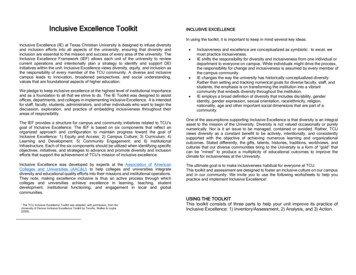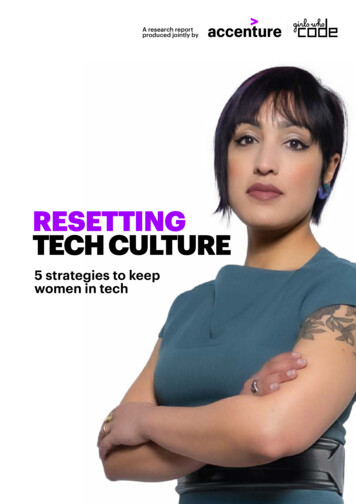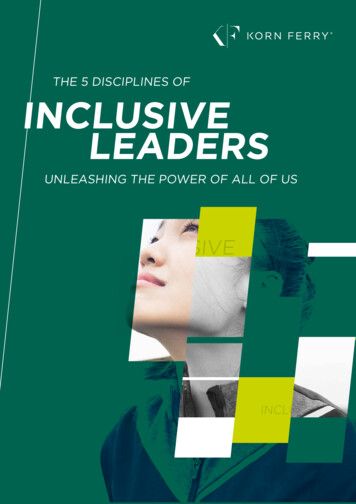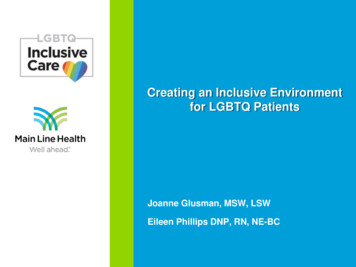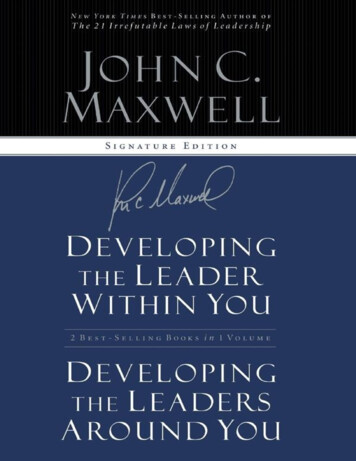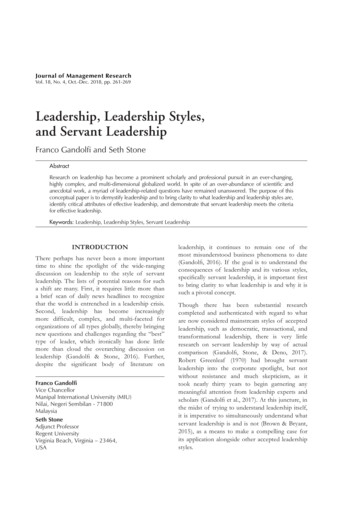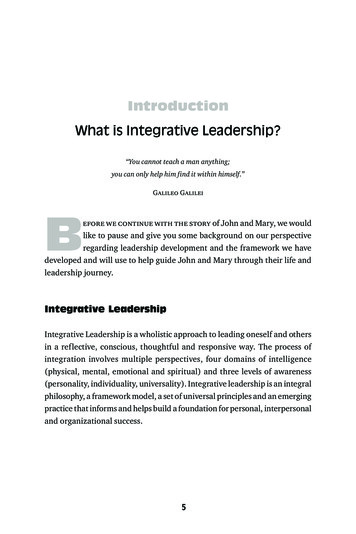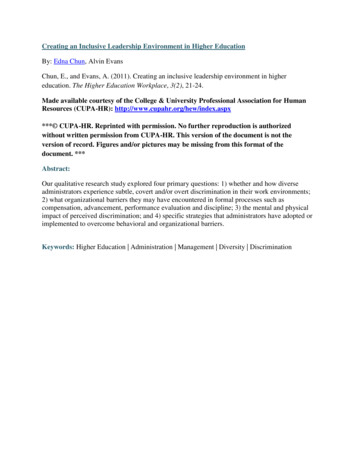
Transcription
Creating an Inclusive Leadership Environment in Higher EducationBy: Edna Chun, Alvin EvansChun, E., and Evans, A. (2011). Creating an inclusive leadership environment in highereducation. The Higher Education Workplace, 3(2), 21-24.Made available courtesy of the College & University Professional Association for HumanResources (CUPA-HR): http://www.cupahr.org/hew/index.aspx*** CUPA-HR. Reprinted with permission. No further reproduction is authorizedwithout written permission from CUPA-HR. This version of the document is not theversion of record. Figures and/or pictures may be missing from this format of thedocument. ***Abstract:Our qualitative research study explored four primary questions: 1) whether and how diverseadministrators experience subtle, covert and/or overt discrimination in their work environments;2) what organizational barriers they may have encountered in formal processes such ascompensation, advancement, performance evaluation and discipline; 3) the mental and physicalimpact of perceived discrimination; and 4) specific strategies that administrators have adopted orimplemented to overcome behavioral and organizational barriers.Keywords: Higher Education Administration Management Diversity Discrimination
20The Higher Education Workplace Spring 2011www.cupahr.org
What is the day-to-day work climate like fordiverse administrators in higher education?For our new book, Diverse Administratorsin Peril: The New Indentured Class in Higher Education(Paradigm, October 2011) we conducted in-depth researchon the experiences of diverse administrators and probedthe dimensions of the collision between everyday workexperiences and asymmetrical systems of power. Usingethnographic research techniques, we have chronicledthe persistence of deeply-rooted patterns of subtlediscrimination through the narratives of administratorsin public and private research universities. We use theanalogy of “indentured servitude” to portray the tenuousthey may have encountered in formal processes such ascompensation, advancement, performance evaluationand discipline; 3) the mental and physical impact ofperceived discrimination; and 4) specific strategiesthat administrators have adopted or implemented toovercome behavioral and organizational barriers.Survey ProcessFor purposes of the study, we contacted administrators inpublic and private research universities in all geographicregions at the level of director and up and invited themto participate in an online survey. Due to the distinctchallenges faced by university presidents as well as theNearly 85 percent of the top-ranked positions indoctorate-granting institutions are held by whitesand 66 percent are held by males.and uncertain employment conditions of administratorswho typically function in “at will” employmentrelationships without security or stability.Unlike faculty whose careers promote individualisticaccomplishments solidified through the tenure process,university administrators usually work withoutemployment protection to support the success ofthe entire institution. Due to their lack of protectionby unions, civil service requirements or tenure,administrators at higher levels in the educationalhierarchy usually serve at the pleasure of an executiveofficer or the president. In difficult budget eras, facultyoften call attention to the number of administratorsand their salaries, based upon a view of administrativepositions as in competition with the purposes of theinstructional enterprise. Yet many are unaware of thecontinual balancing act involved in the daily work livesof administrators or the constant barrage of challengesposed by their precarious employment conditions.Our qualitative research study explored four primaryquestions: 1) whether and how diverse administratorsexperience subtle, covert and/or overt discrimination intheir work environments; 2) what organizational barrierswww.cupahr.orgsignificant body of existing research on presidents, wechose not to include them in this study.Our primary initial point of contact was chief humanresource officers, and we asked them to participatein an online survey and to connect us with otheradministrators on campus. Following completion of theonline survey, we invited respondents to participate ina follow-up interview. The interviews provided a richresource and detailed commentary on the workingenvironment in the research university. Our surveysample was diverse and balanced in terms of race,ethnicity, gender and sexual orientation. The samplereflected a high level of educational attainment andincluded representation from all major divisions of theuniversity.Research FindingsThe research findings document the shape ofdiscriminatory experiences — i.e., how variation isproduced in institutional processes that control access toopportunity, resources and career success. For example,significantly higher levels of mistreatment due to racewere reported by African American administrators whenThe Higher Education Workplace Fall 201121
compared to white administrators. African Americanadministrators also rated their own degree of decisionmaking authority compared to the level of their positionas significantly lower than white administrators.Similarly, Hispanic administrators reported theirdecision-making authority as lower than whiteadministrators.In the book, we share specific accounts that illuminatethe interactions, behaviors and processes that serve as themedium for subtle discrimination. One example: a highranking white female academic administrator relates howearlier in her career her supervisor had combined bullyingwith unethical demands toward her. Since the supervisorfrustration in their roles due to uncertainty about theextent to which their work was genuinely supported.The interviews also underscore the lack of psychologicalsafety in the work environment. A number of minorityand/or female interview respondents expressed genuinefear and concern about sharing their stories, due to thepotential for retaliation or retribution. As a result, wehave eliminated identifying factors from the narrativeaccounts.Our study documents the persistence of a covert systemof subtle discrimination in the administrative ranksthat has replaced the more blatant forms of oppressioncharacteristic of the pre-Civil Rights era. This system[The] chief diversity officers and affirmative actionofficers [we] interviewed expressed frustration intheir roles due to uncertainty about the extent towhich their work was genuinely supported.had the ear of the administration, she felt her only choicewas to leave the institution. The female administratorclearly believed it to be a case of gender discriminationand knew that her supervisor really wanted a male inher role. Lack of support from supervisors, differentialtreatment, lack of participation in decision making,bullying and forms of emotional tyranny includingthreats and psychological domination were some of theconcerns reported by the diverse administrators in ourstudy.The interview narratives in our study reveal that thecontours of subtle discrimination are remarkably similar,irrespective of institutional prestige, public/privateuniversity status and geographical location. And due tothe relative isolation of diverse administrators, the impactof discriminatory experiences is significantly intensified.Diverse administrators are not always aware of thecommonality of their experiences, since they are oftenthe “solo” individual representing diversity in upper-leveladministration.Ironically, chief diversity officers and affirmativeaction officers interviewed for the study expressed22is reinforced and reenacted in institutional settingsthrough cumulative, everyday micro-inequities — small,repetitive, yet difficult-to-prove acts of exclusion andmarginalization. Exclusionary behaviors, acts and eventsexact a particularly high personal and professionaltoll upon diverse administrators. And the precariousemployment conditions of administrators provide anopportunity structure for the exercise of discriminatorybehaviors and practices.Take, for example, the account of one study participant,an African American female administrator. She describeshow her supervisor described her in an open universitymeeting:‘Oh, I don’t mean you. You’re different, you’re anOreo.’ I said to him, ‘I think most people wouldrecognize that as being a racial slur.’ And he says,‘Oh I don’t mean that. You’re one of them that hascommon sense.’ That was when I asked him to pleasestop talking because any more compliments fromhim might really upset me A couple of days afterthat meeting, I went and talked to him [about whathe had said] and used that as a teachable instant.The Higher Education Workplace Fall 2011www.cupahr.org
She proceeds to describe how her supervisor continued tosingle her out, sometimes calling her late in the eveningto give her work assignments due early the next day.The stress she experienced due to the need for constantvigilance was, in fact, life threatening. As she reports:When I had that discriminatory supervisor, I hadextremely high blood pressure. I was on threemedications. They were at the maximum dosageand my blood pressure was still uncontrollable.My doctor kept telling me I needed to quit my jobbecause I was going to have a stroke or heartattack because my blood pressure was so high. [Sincebeing] terminated I don’t take any medication. Itwas clearly the stress from that job.Key aspects of this survey participant’s story areechoed in a number of other narratives in the study.Her experiences reveal the severe mental and physicaltoll arising from discriminatory treatment. In fact,an emerging body of research identifies perceiveddiscrimination as a unique and chronic stressor, creatingdifferential vulnerability to risk factors that affect healthoutcomes.The minority stress model developed by leadingresearchers is an important construct that captures thedouble standards with severe consequences for misstepsand the need for constant vigilance in response to day-today micro-inequities and micro-incursions.For example, one administrator we interviewed — a blackaffirmative action officer — describes how his new whitemale supervisor did not value his years-long experienceand dismissed his expertise, despite his documentedrecord of exemplary service. The administrator explainsthat he felt he was measured by a different standard,having to perform better and be better in everytransaction. Due to the significant stress he experienced,he chose early retirement from the university.An important focus in our exploration of the leadershipenvironment in the research university is thedemographic context of university leadership. Nearly 85percent of the top-ranked positions in doctorate-grantinginstitutions are held by whites and 66 percent are heldby males. The only exception to this pattern is the chiefdiversity officer position — 70.8 percent of these positionsare held by African-Americans, with white incumbentsholding 12.3 percent.A significant body of empirical findings over the lasttwo decades has examined the explanatory potentialof relational demography on workplace outcomes,Lack of support from supervisors, differentialtreatment, lack of participation in decisionmaking, bullying and forms of emotional tyrannyincluding threats and psychological dominationwere some of the concerns reported by the diverseadministrators in our study.incongruence between a stigmatized individual’s needsand the social structures and discriminatory behaviorsthat deplete and exceed adaptive resources. Diverseadministrators interviewed for our study report thecumulative stress arising from their multi-marginalityand the need to perform and succeed in the universityenvironment. Their accounts reveal the application ofwww.cupahr.orgsupporting the proposition that those in power tendto prefer others similar to themselves. Researchershave documented the intensification of the similarityattraction paradigm and in-group preference at higherlevels of the organization as job responsibilities becomemore consequential, non-routine and amorphous.The Higher Education Workplace Fall 201123
In our study, diverse administrators made no bonesabout the challenges they face in gaining the respectand authority associated with a high-level position withresponsibility for supervision of largely majority staffs. Asone African American female administrator explained:We don’t control things we should control It’s aguessing game. I don’t have much say in my ownbudget; hiring — very limited in determining what thelevel of the position should be; serving on committees— there are some committees that [someone in] myposition should represent, [however], I don’t evenknow if I will get an opportunity to be there, nor am Iparticipating in the discussions that would [inform]that decision Within the university environment, we note the absenceof attention or acknowledgement of the influence ofrelational demography upon the career success of diverseadministrators. Our study also includes an extensiveanalysis of how differential treatment can occur inthe processes of hiring, promotion and advancement,compensation, and discipline.We also studied the role of bystanders and the tendency ofmajority group members to make light of harassing actsor to explain them as isolated incidents. As a white maleacademic administrator perceptively explains, majoritygroup members on his predominantly white campusperceive discriminatory incidents as isolated events andfrequently imply that women and minorities are oversensitive. As he states: they have it in their heads that racism,homophobia and gender discrimination don’t reallyexist here. And so, there’s always an explanationas to why so-and-so said this ‘Oh well, you knowhim’, . or ‘oh that’s just an isolated incident.’ [But][t]hese isolated incidents keep happening over andover again The belief in a just system causes some bystanders toblame the victims of discrimination. And we see throughthe survey’s narrative accounts how acts of subtlediscrimination escape institutional notice under thecloak of meritocratic justification. The administrativesystem itself contains few, if any, safeguards to protectdiverse administrators from such exclusionary treatment.24Best Practices and FutureRecommendationsThe overarching purpose of our research is to assistuniversity leaders, human resource and diversity officers,faculty and key governance groups in the developmentof more inclusive, empowering leadership practicesthat replace hierarchical, coercive models and reflectthe democratic purposes of higher education. Diverseadministrators themselves expressed the hope that thestudy would contribute to the improvement of theirworking conditions and would increase awareness of thechallenges they face.A number of human resource professionals in our samplearticulated their desire to influence the change process.Yet, surprisingly, only a few HR professionals offeredexamples of systemic approaches, initiatives or programsthey have implemented to counteract the impact of subtlediscrimination in organizational processes and campusculture. This finding may be due to the often secondaryrole of human resources in the organizational hierarchyas well as the lack of explicit identification of diversityissues as a human resource responsibility. One prominentHR professional noted the lack of acknowledgement ofsubtle discrimination by HR practitioners that hindersefforts to correct existing practices.The poignant yet courageous testimonials of diverseadministrators point the way to needed structural,cultural and behavioral changes that will strengthenemployment stability for administrators andensure their retention. Since talent is the driver ofinstitutional vitality, these changes will not onlyenhance the success of diverse administrators, but willimmeasurably contribute to the dynamism, viability andcompetitiveness of our American institutions of highereducation.Edna Chun is associate vice chancellor for human resourceservices at the University of North Carolina at Greensboro.She can be reached at e chun@uncg.edu.Alvin Evans is associate vice president for humanresources at Kent State University. He can be reached ataevans3@kent.edu.The Higher Education Workplace Fall 2011www.cupahr.org
Creating an Inclusive Leadership Environment in Higher Education By: Edna Chun, Alvin Evans Chun, E., and Evans, A. (2011). Creating an inclusive leadership environment in higher education. The Higher Education Workplace, 3(2), 21-24. Made available courtesy of the College & University Professional Association for Human Resources (CUPA-HR):
